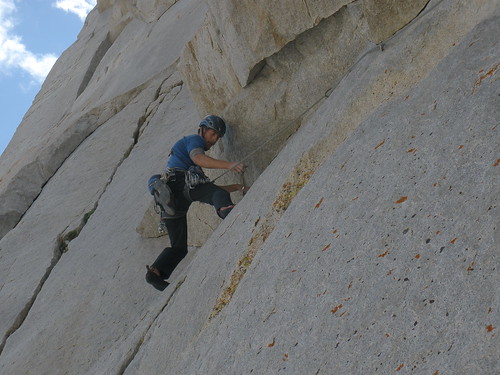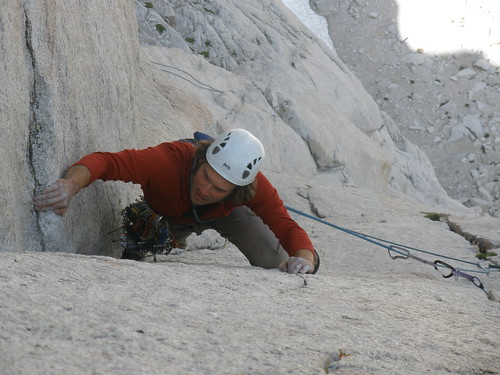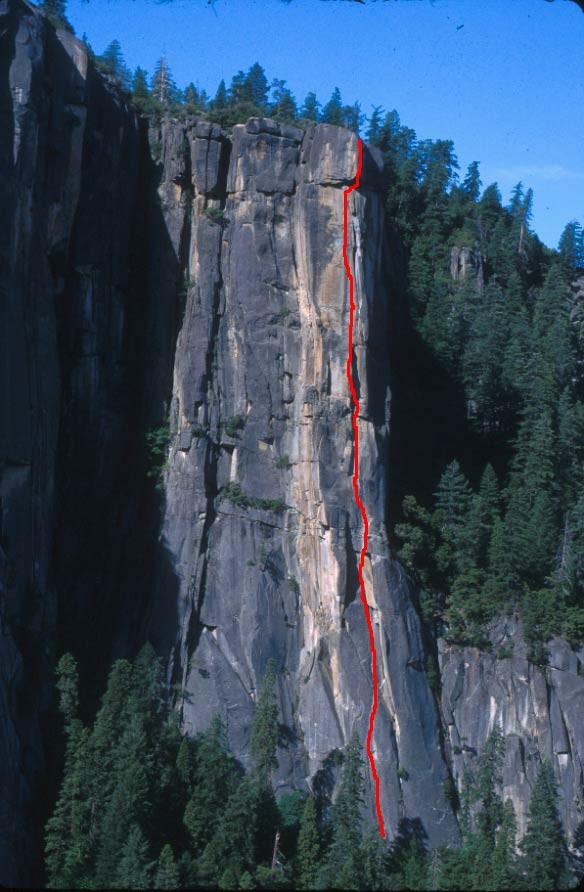"Why I love Rock Climbing"
Saturday morning, 4am, my cell phone alarm goes off, and I don't know why. For about 5 seconds. Then I remember, today is the big day: the Grand Traverse.
 The Traverse. Parts where the red line disappears you traverse on the far side of the ridge. Photo credit: John Ross.
The Traverse. Parts where the red line disappears you traverse on the far side of the ridge. Photo credit: John Ross.This is a goal I've been planning for all summer, in fact, maybe since I started climbing. Ever since coming here with my Dad and the Boy Scouts when I was 15, I've known that I would climb these mountains. To be here with the ability and confidence to try it is a great feeling.
So, the idea is that, instead of climbing a single peak, one follows a ridgeline of consecutive peaks, summiting each one, and navigating the steep terrain in between. The central part of the Teton range lends itself well to this goal. From the summit of Mt. Teewinot (12, 325'), the ridgeline makes its way past Mt Owen, The Grand Teton, Middle Teton, South Teton, and then down a ridge of many smaller towers before ending at Nez Perce. The ridge stays above 11,000' the entire way, and on the Grand tops out at 13,770'.
Anyways, after a quick breakfast burrito, I arrive at the trailhead. Departing at 5am, it's still pitch dark, but luckily I'm on a clear trail. My shivers in the chill morning air quickly give way to sweat, and soon my shirt is drenched and my forehead dripping as a make the grueling ascent. From the parking lot, you gain over 5,500' before summiting Teewinot. I make this in 2 hours, enjoying the sunrise as I do, and from the summit the entire valley is lit up before me.
 Summit of peak #1, Teewinot. The North Ridge of the Grand follows the right side of the face in the background.
Summit of peak #1, Teewinot. The North Ridge of the Grand follows the right side of the face in the background.From here, the real fun begins. Teewinot is just a steep 4th class scramble, but from here I'll be on the ridgline, and it's technical and steep most of the way. Many minor steps and drops must be negotiated, each requiring real climbing. A bigger challenge, though, than the actual climbing, is the route-finding. It might seem that following such a steep and exposed crest would be straightforward, but not so. A multitude of obstacles are confronted, mostly small towers and cliffs, and at each one you must decide which way to go. Every step, every hold, every movement represents a descision, and it's this problem solving challenge that I love most about Rock Climbing. Not only is it an intense physical effort, but your mind must be in a constant state of analysis and reaction to your surroundings. Many, many mistakes will be made throughout the course of a big day like the Grand Traverse, but the secret to success is recognizing and correcting them, not letting small mistakes demoralize you, and not letting them compound into major ones.


 These pictures are for my Mom. I hope you don't get too stressed out reading this.
These pictures are for my Mom. I hope you don't get too stressed out reading this.One highlight of my day came early on, on the ridge between Teewinot and Owen. As I'm downclimbing a rather steep section, I look over and see a party of two rappelling. Once I reach them, I recognize them: George Lowe and Jack Tackle, two old-school legends of American mountaineering (I might not have actually recognized them had the climbing ranger the day before not told me that they'd be up here, but I definitely know who they were). George, with his full head of white hair, is one of the Deans of hard climbing in the Tetons, but he's never successfully done the whole Traverse. He and Jack have started early, and they're making good time. It's amazing to see these guys move with such confidence, a legacy of a lifetime spent in the mountains.
 George Lowe (below) and Jack Tackle negotiating some snow between Teewinot and Owen.
George Lowe (below) and Jack Tackle negotiating some snow between Teewinot and Owen.Anyways, after exchanging quick greetings, they give me some tips on the sections ahead, and then I'm off towards Owen. There are two ways to summit Owen from here. The most obvious, since I'm approaching from the east, is the East Ridge. The easiest, though, is to traverse low on the south side of the mountain to the west side and ascend the easy Koven Chimney. I choose the East Ridge, thinking it will be more direct. And it probably would have been, had there not been a steep snowfield guarding the approach. At the base of it, the snowfield didn't look too bad, and my brand new ice ax gave me the confidence to start up it. As I neared the top, though, it became steeper, and sloped off to the north, straight down to a huge cliff. A mistake here could start me sliding irreversibly towards the bottom of Cascade Canyon, thousands of feet below. I slowed down, spent more time kicking each step, and eventually made it to the security of the rock. From here, the 5.6 rock route to the summit was a breeze. As I started to descend the Koven chimney on the west side of the peak, George and Jack were starting up it, which conveniently showed me which way to go.
 #2, Mt. Owen
#2, Mt. OwenAnother cruxy section of the traverse lay ahead, and I had to stay alert. Here, one has to switch side of the ridge, which has become extremely steep and knife-edged. Finding the correct spot to climb over is difficult, and I spend much time scouting out different options. After some scary and exposed climbing on loose rock, I find a passage over the ridge. Again, it's not clear where to go, but I see some ledges down a few hundred feet, and they appear to offer passage around the steepest sections. After some wandering downclimbing, I gain the ledge system, which thankfully takes me directly into "The Gunsight", a very prominent notch in the ridge. Viewing it from below, it had seemed like this would be a very difficult section, and I was happy to have found the way into it.
Getting out of the deep notch also proved a challenge, with tricky 5.7 climbing, but luckily the rock here was of good quality and the holds plentiful. From there, a long but easy section of scrambling and hiking brought me to the Grandstand, a huge ledge just below the North ridge of the Grand Teton. The North Ridge would be the biggest section of near vertical climbing for the day, and also some of the toughest. After some easy 5.6, the first real challenge was a snow-filled gully/chimney system. I had to get up it to access the next ledge, and so out came the ice ax. A short, but gripping session of kicking steps led me to the next ledge, and again reminded me how much I love the security of good rock! From here, the main North Ridge route looked icier still, so I chose to climb a variation called the Italian cracks. This went well, with steep, but secure 5.7 climbing, and soon I was at another huge ledge. From here, instead of continuing up the icy North Ridge, I traverse around to the right onto the West face, hoping to join up with the easy Owen-Spalding route. This hope was denied by a huge ice-filled chimney, so I climbed straight up the West Face, finding a wandering, but moderate passage to the summit.
 #3, The Grand. The Detroit Tigers are #1 in their division, up 4 games with only 32 to go. Go Tigers!
#3, The Grand. The Detroit Tigers are #1 in their division, up 4 games with only 32 to go. Go Tigers!On the summit, it's a party! Having been alone in my head for most of the day, it's a sudden shift to be sharing the top with 20+ people. Everyone else has come up either the Owen-Spalding or the Exum, and they're enjoying one of the last good weekends of weather this season. As I downclimb the O-S, I pass many more people, some of them grumpy from having waited hours for the traffic jams to clear. Maybe some of them should have climbed the North Ridge, I didn't see anyone else there. Arriving down at the lower saddle, between the Grand and Middle Tetons, I fill up water and look at the sky. It has been sort of hazy and cloudy all day, not the typical alpine bluebird day, and now I start to see some even darker clouds forming in the west. I know that these high summits and ridgelines are the last places I want to be if it storms, but I'm comfortable with the fact that I can move quickly and escape back to the valley if need be.
 Looking west to Iceberg Lake and upper Cascade Canyon
Looking west to Iceberg Lake and upper Cascade CanyonStarting up Middle Teton, my legs are definitely feeling the burn, but my spirits are high. The North Ridge of Middle (5.6) is last big technical section, and summiting feels great. I run down the Southwest Couloir, with fantastic views of Iceberg lake and of the Teton Crest trail, and swing across the saddle. Up the ridge to South Teton, my legs are even more sore, and the sky is getting darker by the minute. Upon reaching the summit, it's decision time: continue or retreat? From here I can see the end, only a few towers and peaks down the ridge to Nez Perce. The problem, though, is that retreat from any further point along the ridge is unknown, whereas I can easily retrace my steps back to the South-Middle Teton saddle and pick up the trail into Garnet Canyon. Lightning flashes, thunder crashes, and my decision is made: retreat!
 Peak #4, Middle Teton. Note the building clouds, which would distract me from taking summit pic #5, South Teton, as I ran for cover.
Peak #4, Middle Teton. Note the building clouds, which would distract me from taking summit pic #5, South Teton, as I ran for cover.Oh well, it's still been a great day, with 5 major summits, tons of great steep rock climbing, and something like 11,000' of vertical gain. Not a bad outing. The trail back down Garnet Canyon is long and grueling on my sore knees, but eventually I make it down, reaching the car around 7pm. Along the way, I pass and talk to many folks who've had great days in the mountains, and I'm glad that they're all down safely before the storm. In the parking lot, I score a PBR from some nice folks who climbed the Exum ridge (on the Grand), and though it's warm, it tastes great (thanks!).






















